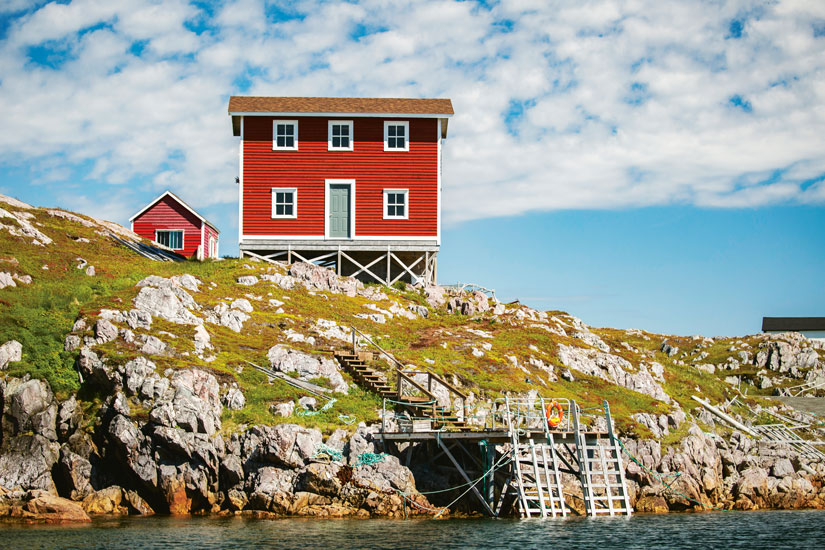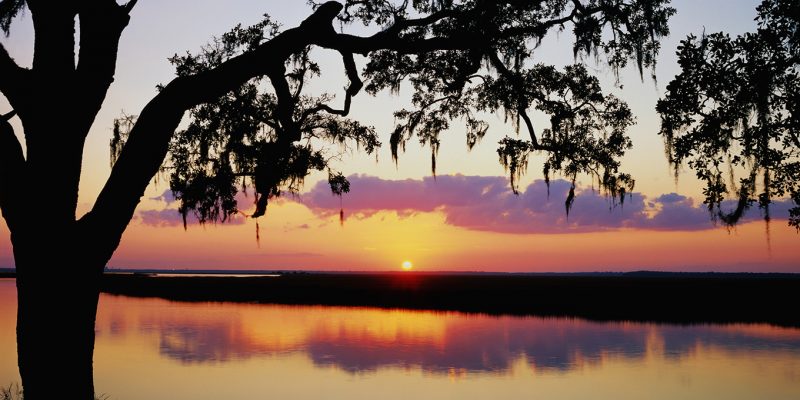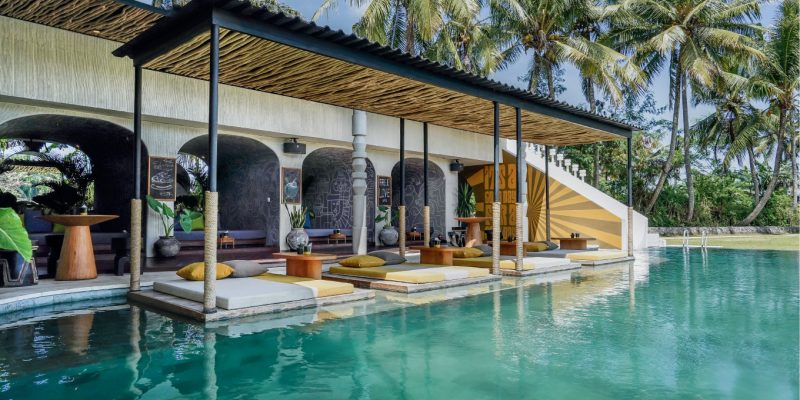A journey along Canada’s eastern edge goes off-road in the best possible way.
“It’s like another world out here,” says Gerard Greene, as he carefully steers our speedboat through the shoals of Little Fogo Islands, an archipelago eight kilo-metres off the northern coast of Newfoundland’s Fogo Island. No one lives at this outport anymore — except the thousands of puffins, murres and other seabirds whose nests are perched along the clifftops — but a handful of saltbox and biscuit-box houses and fishing stages, in various states of disrepair, are still propped up on stilts along the rocky shorelines. Several have recently been revived with coats of bright paint and are being used as summer cottages.
On this sunny late-July day, with wisps of white clouds in the sky above and clear blue water below, it’s easy to see why most locals, including Zita Cobb, the driving force behind the nearby Fogo Island Inn, consider these traditional fishing grounds a “sacred homeland.” They know these islands well. Greene navigates through the “tickles” (straits) using a friend’s carefully hand-drawn map, which seemingly notes every rock and shoal.

Fogo Island Inn.
While my mom steadies herself by keeping an eye on the horizon, Greene, a retired teacher, shows me how to “jig the codfish” with a hook and line. He hands me a wooden spool attached to 45 metres of line, which I unwind over the edge of the boat. I soon feel a tug. “I got one!” I call out. When the silvery speckled fish starts to thrash near the surface, Greene helps me hoist it into the boat. As it continues to flop around, I can’t contain my excitement about catching a bona-fide Newfoundland cod. Neither can my seasick mother, it seems, as she leans over the side of the boat…indicating it’s definitely time to head back to shore.
Two days earlier, we had set out on this eight-day, 1,500-kilometre road (and ferry) trip from Gander to Deer Lake, taking a circuitous route to two of the province’s 7,000 islands — Newfoundland’s Fogo Island, off the northeastern coast, and Labrador’s Battle Harbour, 300 kilometres northwest of Fogo. Both islands are home to iconic hotels that, while very different in their mix of modern and historic aesthetics, are deeply connected to the land and its people—and even to each other through the generations of islanders who have lived and fished at both outposts.

“Get-your-feet-up” chair at Fogo Island Inn.
At Fogo Island Inn the next morning, after devouring warm berry scones that were delivered to our room before we even got up, I feel as cheerful as our suite’s yellow “get-your-feet-up” wooden settee. (Yes, that’s its official name, and it’s strategically placed right next to the floor-to-ceiling windows overlooking the North Atlantic.) So I head to the inn’s nearby woodshop for a chat with Kingman Brewster, who moved here four years ago from Brooklyn, N.Y., to oversee the construction of the property’s custom furniture line, which perfectly complements the 29-room inn’s modern-handmade vibe. Through various collabs with designers from around the world, the Fogo Island Shop has found a way to reinterpret—and give a contemporary twist to — the area’s traditional wooden outport furniture styles.
I tell Brewster about how, earlier in my visit, I was poking around some 1940s-era fishing stages in nearby Tilting, when I got to talking with Ed Greene, who invited me across the street to see his father’s traditional saltbox home. (It’s perhaps no surprise that, in this small community of 2,700, Ed is a cousin to Gerard, who took us fishing.) Inside the low-ceilinged house, my eye is immediately drawn to a simple brown-painted wooden settee in the kitchen, an original iteration of the larger-scale piece back in my suite. I also spot the signature “F.U. green” paint colour on the wall, named after the minty hue used in the province’s old Fisherman Union general stores; a slightly subtler shade can be found on the walls of the library back at the inn. I explain to Brewster how lovely it was to discover these connections first-hand.
“You can see how easy it is to get knee-deep in the work,” he replies. His sentiment echoes that of Cobb, who personally invested millions of dollars to build the inn through the non-profit Shorefast Foundation. For her, it’s a way to preserve the identity of the island, encourage economic growth and invest in the place where she grew up. Since its completion in 2013, the inn has put Fogo Island on the map as an internationally renowned destination.

Lion’s Den trail on Fogo Island.
To make the most of our final spare moments on Fogo, my mom and I get back in the car and head for Lion’s Den, where a 5.5-kilometre looping trail offers picture-perfect views of the jagged coastline, marshes and ponds. The sun is out, and hundreds of blooming purple pitcher plants, the province’s official flower, line the trail. We even happen upon a local berry picker, who shows off his precious haul of early-season bakeapples (also known as cloudberries). This island, like the inn itself, has all the ingredients needed to fully enjoy a slower pace of life. If only we weren’t beholden to things like ferry schedules….

A Newfoundland road sign.
Back on the mainland, and back on the road, we head up the western edge of Newfoundland’s Northern Peninsula and catch a ferry across the Strait of Belle Isle to Labrador. Here, we finally get a taste of the “pea-soup” fog the province is famous for. The Red Bay whaler’s cabin where we spend the night is so fogged in we can’t really situate ourselves. “It’s been weeks since we’ve seen the sun,” owner Marilyn Bridle tells us, explaining that the haziness is unusually intense for July.
In the morning, the fog has (somewhat) lifted, and we more fully appreciate its power when, to our amazement, we discover our view out to a gargantuan rusted ship and a blue-tinged iceberg just 50 metres out in the bay. But even before we set off for the day, these enchanting sights begin to recede again. While I can imagine how difficult it must be to live with this kind of weather long-term, as a visitor I’m quite mesmerized by the otherworldly whiteout magic of it all.

Two icebergs spotted from the Iceberg Hunter.
Now the only major thing still left on our road-trip must-see list (cod: check; icebergs: check; fog: check) is a moose. My mother has her sights set on seeing at least one of the 115,000 that (apparently) overrun the province. But, with 89 kilometres of fogged-in gravel road still to cover before we reach the dock in Mary’s Harbour, where a passenger ferry will take us to Battle Harbour, I’m okay with skipping a moose encounter right now. (Sadly, with nothing larger than an Arctic fox on the isle and no moose sightings during our final drive to Deer Lake, my mother was, surprisingly, out of luck.)

Some of the picturesque scenery at Battle Harbour.
The tiny island we’re heading to is completely walkable, and no vehicles are allowed; it feels good to ditch the car for a few days. As the aptly named Iceberg Hunter ferry cuts through the Labrador Sea toward the historic fishing community, it delivers on its name: There are several building-size hunks of ice to gaze at on the horizon. We arrive on shore just in time for a homespun lunch of cod cakes and coleslaw, and the meal provides an opportunity to meet the handful of like-minded guests who have travelled so far to stay at this unusual National Historic Site. It’s the only one in the country that has been reborn as a summer getaway, complete with a quaint five-room inn and an eight-room merchant house, as well as five guest cottages—and what is likely the remotest spa on the continent. (Similar to Fogo Island Inn, where any profits are re-invested in the community via the Shorefast Foundation, this place is managed as a non-profit through a charitable trust.)
In the communal dining hall, I’m seated next to fellow guest Jean Claude Roy, who tells me about how he fell in love with Newfoundland when he first came from France for a visit in 1966. In the past few years, he has become Battle Harbour’s unofficial resident artist, spending several weeks oil-painting here each summer. He now lives in the province seven months a year in an ongoing effort to “paint every community in Newfoundland.” (He has already published Fluctuat Nec Mergitur, a 480-page visual monograph of his Newfoundland paintings, and he’s about to finish a similar collection for Labrador.)

Battle Harbour’s merchant house hotel.
After lunch, Janice Walsh, a local volunteer from Mary’s Harbour, gives us a tour of some of the original buildings, which date back to the late 18th century, when this was a major hub for commercial cod, seal and salmon fishing. Because of all the salt that was used here to preserve the fish, some of the wooden storehouses and artifacts feel brined. You can even smell it in the air. Walsh, whose great-grandfather came here with Baine, Johnston & Co., one of the original merchant companies, visited this community when she was a young girl, and today she has a summer home here. “Most of the people who work here have a connection to this island,” she says.

Some of the historic houses on Battle Harbour.
Later, I head down to the island’s wash house, where fishermen used to clean up after getting off their boats. Lisa Walsh (no relation to Janice), founder of the organic local beauty line Indigena Skincare, based out of Topsail Beach near St. John’s, has transformed the space into the rustic but relaxing Wash House Spa. As she treats my face with fermented blueberry and dried laminaria (kelp) exfoliants, a sea-veggie mask and Labrador tea cream, she tells me about how she hand-gathers many of the bakeapples, partridgeberries and other ingredients for her small-batch products.
“I love snorkelling for seaweeds!” she says, like it’s a totally normal thing to collect your own algae. “The water is freezing cold, but it’s great for my cellulite,” she quips. She’s busy the day I visit — a float plane full of guests from the nearby Rifflin’ Hitch fly-in fishing lodge has arrived so they can enjoy an afternoon of facial massages and body scrubs (plus lunch and a historic tour). Walsh is quickly becoming the province’s go-to guru on locally sourced beauty products. (She also now supplies Fogo Island Inn with its in-room amenities.)

Some of the picturesque scenery at Battle Harbour.
The next day, Peter Bull, executive director of the Battle Harbour Historic Trust and sometime tour guide, offers to take us across the tickle to hike around Great Caribou Island, but instead we opt to spend more time exploring the land we’re already on. We leisurely climb around the “gulches” — big breaks in the cliffs where the sea rushes up — wander past a First World War-era Marconi radio station and search out the rusted wreckage of a small plane that crashed in 1976. We also spend time looking at intricately carved headstones in the old cemetery — and just breathing in the Labrador Sea air. We’re not too worried about what we don’t get to. There will be time tomorrow.

Jean Claude Roy painting.
On our way back to our room at the newly renovated inn, we come across Roy painting one of his plein-air scenes. For this one, he’s focusing on a dirt road in the foreground with saltbox houses in the distance. “Sometimes it is so foggy you can only see three buildings,” he says, explaining that the summer fog is different from the spring fog. There’s no fog at the moment, but the sky is overcast, offering him another mood to capture. “I could paint here for three years,” he says. There really is something about Newfoundland and Labrador that makes you want to linger. I’m not in a hurry to hit the road anytime soon either — other than continuing my stroll down the one in the painting.
DETOURS: Exit the Trans-Canada Highway to discover 3 more off-the-beaten-path driving adventures.

Alberta’s Badlands.
HIT THE BADLANDS It would be almost sacrilegious to do a road trip across the Canadian prairies without stopping to see the world’s largest moose/Easter egg/dinosaur, etc. So before you head up the Dinosaur Trail northwest of Drumheller, Alta., you need to check out the view from the city’s 25-metre-tall T. Rex. Next stop: must-see dino mecca the Royal Tyrrell Museum, where new exhibits just opened this spring. Then go north to Horsethief Canyon, where cowboys once hid their stolen horses among the distinctive hoodoos. Continue across the Red Deer River via the Bleriot ferry before you loop back down the North Dinosaur Trail on the other side of the river. On the way back to Drumheller, stop at the Orkney Viewpoint — preferably around sunset — for a stellar view of the Badlands’ red-rock cliffs. Total mileage: 50 kilometres.

B.C.’s Okanagan Valley.
GET ELECTRIC New electric-car-charging stations are popping up every day. So why not book a Nissan Leaf through Vancouver-based car-sharing service Modo and head for the Okanagan Valley, one of B.C.’s densest charging zones? It will take some serious planning since the car’s charge range is small, but the PlugShare app will help you choose charging stations, which are located everywhere from provincial parks to wineries. Total mileage: 1,046 kilometres round-trip from Vancouver to Kelowna (via Osoyoos).

Tuktoyaktuk in the Northwest Territories.
GO NORTH For the first time, Canadians will soon be able to drive all the way to the Arctic coast in summer. The missing link to an ice-road-free trip is a new 120-kilometre-long all-season road that will connect Inuvik to Tuktoyaktuk, which sits on the coast of the Beaufort Sea in the Northwest Territories. The road is expected to be finished in the fall of 2017 — giving adventurous travellers who want to go beyond the already legendary Dempster Highway an even farther-flung way to celebrate Canada’s 150th birthday next year. Total mileage: 7,180 kilometres round-trip from Calgary to Tuktoyaktuk.
Newsletter
Join our mailing list for the latest and biggest in fashion trends, beauty, culture and celebrity.
Read Next

Fashion
With the New Professional Women’s Hockey League, Athletes’ Personal Style Takes Centre Ice
Lexie Adzija, Mariah Keopple and Sarah Nurse on what goes into a game-day outfit.
by : Patricia Karounos- May 8th, 2024

VIP
Media Mogul Victoria Unikel Launches Debut Sci-Fi Novel and Art Collection
Victoria Unikel used channelling to write a children’s sci-fi adventure novel and launch a scandalous-art collection. It’s her life in glamour, art and different galaxies, all at once.
by : Contributor Content- May 8th, 2024

Fashion
8 Sparkling Jewellery Gifts to Give This Mother’s Day
Show your gratitude with pieces they’ll have forever and ever.
by : ELLE Canada- Apr 29th, 2024





